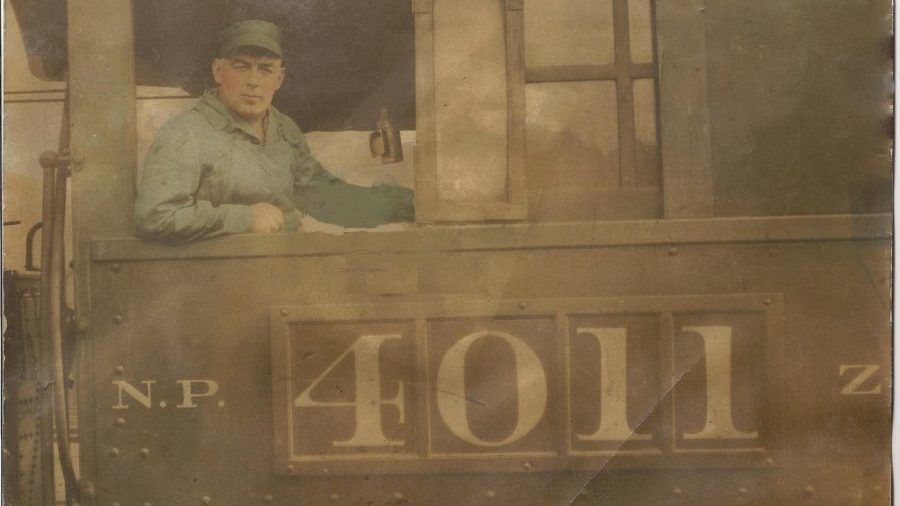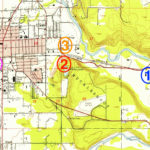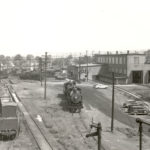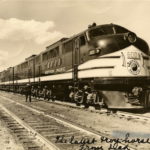All Over The Map: How an Auburn family stayed in touch by locomotive and dish towel
Jan 14, 2022, 8:06 AM | Updated: 8:41 am
Auburn used to be a serious railroad town.
“Auburn was the western terminus of the Northern Pacific,” said Gary Tarbox, director emeritus of the Pacific Northwest Railroad Archive. “There was a double ‘Y’” – or junction – in Auburn, where “one side went to Seattle, the other side went to Tacoma. It was a major sending point for anything going east, and a major arrival location for trains coming west.”
With a huge railyard where long freight trains were assembled and a roundhouse where locomotives were serviced, Auburn was a critical part of the Northern Pacific – one of the American transcontinental railroads which, through a series of mergers, became what today is called the BNSF Railway.
And it was in this serious railroad town more than 70 years ago where one railroad family who lived in Auburn devised a unique way to keep in touch in an era long before cellphones or other personal communication devices.
Dennis Brooke shared this story about his great-grandfather, who was a railroad engineer for the Northern Pacific for much of the first half of the 20th century.
The railroad engineer’s name was Frank Cavanaugh. He lived for decades in Auburn with his wife in a house on ‘R’ Street, not too far from the east-west Northern Pacific railroad tracks.
Cavanaugh drove trains for the Northern Pacific for many years, and he often drove his locomotive right by his own house. Because of this, he and his wife developed a special way to communicate when Cavanaugh was nearing the end of his shift, and was heading west on the Northern Pacific tracks which crossed the Cascades over Stampede Pass.
The Cavanaugh’s grand-daughter, Jonie Cavanaugh Brooke, is Dennis Brooke’s mom. She’s 84 now, and actually witnessed her grandparents using their special communication method several times from inside the family house on ‘R’ Street back in the 1950s.
“Grandma lived about three blocks from the railroad track, Northern Pacific,” Jonie Cavanaugh Brooke told KIRO Radio. She said that as he was nearing the end of his workday, her grandfather Frank Cavanaugh “would come in from probably Lester or Yakima, and he would give her a signal, a toot-toot.”
The landmark that westbound Frank Cavanaugh used as his cue to toot the locomotive’s whistle was the Neely Mansion, which still stands alongside the tracks, just east of where the Cavanaugh home on ‘R’ Street once stood on the edge of a field. That field is gone, says Dennis Brooke, and an apartment house replaced the Cavanaugh home decades ago.
But apart from being a distinctive way of saying hello to his wife, the steam whistle was a little more than this, says Jonie Cavanaugh Brooke – and grandpa’s audible toot-toot required a visual response from grandma.
“She would run looking for something white – [and] open the window – and then she would flail a little white rag out so that he would see that she’d heard it,” Jonie Cavanaugh Brooke said, though the exchange wasn’t sometimes without a level of drama.
“She would wander all through the house finding that white rag or that white tea towel so that she could flail it at him,” she said, “instead of being smart and leaving one by the window all the time.”
The whistle, it turns out, was a signal that grandpa would soon need a ride home.
“Ten minutes later, she’d take off and go pick him up from the roundhouse, because they only had one car back then,” Jonie Cavanaugh Brooke said.
Since that one car was a coupe, Jonie Cavanaugh Brooke and the other grandkids would all pile into the back and ride the mile or so to the Northern Pacific roundhouse, standing up behind the front seat. The kids would hang on to the back of the seat, she says, because in those days, there were no seatbelts yet, of course.
With so many railroad employees living in Auburn in those years, the Cavanaughs weren’t necessarily the only Auburn family doing something like this to keep in touch. Frank Cavanaugh’s career spanned the steam era of locomotives (with steam whistles) and the changeover to diesel locomotives (with air horns). Jonie Cavanaugh Brooke says her grandfather used both kinds of signaling devices to hail her grandmother over the years.
Jonie Cavanaugh Brooke clearly loves her family history and her community’s history, and she says she feels bad that the old Northern Pacific roundhouse no longer stands in Auburn.
Hilary Pittenger is curator of collections at the White River Valley Museum & Mary Olson Farm in Auburn. She says that while the roundhouse is indeed gone, if you know where to look, you can still see evidence of it.
“It was demolished in 1987 over a series of months,” Pittenger wrote in an email. “[But] you can still see the outline of the roundhouse if you look over the side of highway 18 while traveling east.”
And though the roundhouse is gone, BNSF still operates a major railyard in Auburn, and still runs trains over Stampede Pass and through the double “Y” in Auburn. Maintenance has moved to Interbay in Seattle.
Meanwhile, one stretch of tracks in Pierce County where Frank Cavanaugh used to drive locomotives was converted to the Foothills Trail between Puyallup and Buckley.
“The Foothills Trail is really quite amazing,” Gary Tarbox said, “because it’s all nicely [paved with] asphalt. And they put in a very fancy bridge over the river. It’s incredible what Pierce County and the state of Washington and federal funding has done for that trail.”
The Foothills Trail is a great place to bike or hike, but if you plan on walking or riding along its gentle grades, and if there’s any chance you might need a ride home, better plan on bringing a cellphone along.
You can hear Feliks every Wednesday and Friday morning on Seattle’s Morning News, read more from him here, and subscribe to The Resident Historian Podcast here. If you have a story idea, please email Feliks here.


















